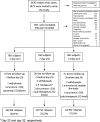Efficacy of three different regimens of primaquine for the prevention of relapses of Plasmodium vivax malaria in the Amazon Basin of Peru
- PMID: 24752682
- PMCID: PMC4080559
- DOI: 10.4269/ajtmh.13-0053
Efficacy of three different regimens of primaquine for the prevention of relapses of Plasmodium vivax malaria in the Amazon Basin of Peru
Abstract
We evaluated the efficacy of three primaquine (PQ) regimes to prevent relapses with Plasmodium vivax through an open-label randomized trial in Loreto, Peru. Vivax monoinfections were treated with chloroquine for 3 days and PQ in three different regimes: 0.5 mg/kg per day for 5 days (150 mg total), 0.5 mg/kg per day for 7 days (210 mg total), or 0.25 mg/kg per day for 14 days (210 mg total). Biweekly fever assessments and bimonthly thick smears were taken for 210 days. Recurrences after 35 days were considered relapses. One hundred eighty cases were enrolled in each group; 90% of cases completed follow-up. There were no group-related differences in age, sex, or parasitemia. Relapse rates were similar in the 7- and 14-day regimes (16/156 = 10.3% and 22/162 = 13.6%, P = 0.361) and higher in the 5-day group (48/169 = 28.4%, P < 0.001 and P = 0.001, respectively). The 7-day PQ regimen used in Peru is as efficacious as the recommended 14-day regimen and superior to 5 treatment days.
© The American Society of Tropical Medicine and Hygiene.
Figures




Comment in
-
Improving the radical cure of Plasmodium vivax malaria.Am J Trop Med Hyg. 2014 Jul;91(1):3-4. doi: 10.4269/ajtmh.14-0118. Epub 2014 Apr 21. Am J Trop Med Hyg. 2014. PMID: 24752685 Free PMC article. No abstract available.
References
-
- World Health Organization . World Malaria Report. Geneva: World Health Organization; 2012.
-
- Baird JK, Hoffman SL. Primaquine therapy for malaria. Clin Infect Dis. 2004;39:1336–1345. - PubMed
-
- Klein TA, Tada MS, Lima JB, Tang AT. Infection of Anopheles darlingi fed on patients infected with Plasmodium vivax before and during treatment with chloroquine plus primaquine in Costa Marques, Rondonia, Brazil. Mem Inst Oswaldo Cruz. 1992;87:191–195. - PubMed
-
- Bray PG, Deed S, Fox E, Kalkanidis M, Mungthin M, Deady LW, Tilley L. Primaquine synergises the activity of chloroquine against chloroquine-resistant P. falciparum. Biochem Pharmacol. 2005;70:1158–1166. - PubMed
-
- Baird JK, Basri H, Subianto B, Fryauff DJ, McElroy PD, Leksana B, Richie TL, Masbar S, Wignall FS, Hoffman SL. Treatment of chloroquine-resistant Plasmodium vivax with chloroquine and primaquine or halofantrine. J Infect Dis. 1995;171:1678–1682. - PubMed
Publication types
MeSH terms
Substances
Grants and funding
LinkOut - more resources
Full Text Sources
Other Literature Sources

